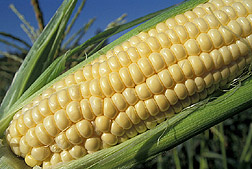Forum—A Systems Approach to Corn
The United States is the world’s largest producer and exporter of corn grain, producing more than 40 million metric tons each year. Eighty million acres of land in this country are planted to corn, with the majority being grown in the Midwest, and about 20 percent of our crop is exported. As one of America’s major agricultural crops, corn brings in billions of dollars every year.
In addition to being an important food source for humans, corn and its coproducts are increasingly being used as animal feed and to develop biofuels, plastics, adhesives, and medicines. As uses and world demand for corn increase, so must our knowledge of the plant. This is why the Agricultural Research Service is taking a systems approach to corn by examining the factors that play important roles in producing this valued crop and how we can use them to our advantage.
ARS is proudly leading the way in examining the rich genetic diversity of corn, key to future advances in crop breeding and improvement. ARS scientists and university cooperators have recently developed the Nested Association Mapping (NAM) population, the largest plant genetic resource ever assembled. (See “Opening Up a New World of Maize Traits” in this issue.) NAM captures almost all of corn’s genetic diversity. With this extremely useful tool, we are moving from manipulating just one gene to exploiting multiple genes for complex traits.
Working closely with other government agencies and universities, ARS is pioneering the use of new genetic resources and methods for crop improvement. For example, some of our scientists are working on projects funded by the USDA National Institute of Food and Agriculture, the U.S. Department of Energy, and the National Science Foundation to apply information gained from corn research to improve several types of plants for biofuel production. One project focuses on selecting genetic regions in corn’s DNA that will improve the plant’s energy value.
ARS is also working with other countries to improve corn. ARS and Mexican scientists have collaborated in maize and teosinte genome-sequencing projects, funded by the National Science Foundation and the Mexican government. Teosinte is a wild relative of corn and widely believed to be corn’s ancestor. Insight into these genomes will help us learn what genes have been manipulated as corn has been domesticated and, more importantly, what genes we can manipulate to improve corn even more.
We have developed other useful tools in corn that will help all crop breeders select and utilize genes for valuable traits. ARS scientists and colleagues are using mutant corn genes as ‘reporters’ to identify novel genes and gene variants for traits of interest. (See “Want To Know What a Gene Does? Use a Little Magic” in this issue.) And the ARS-led Germplasm Enhancement of Maize (GEM) project is looking to broaden the genetic base of our country’s corn crop by crossing exotic corn germplasm with currently used lines to help growers access valuable traits that may not have otherwise been available to them. (See “Genetic-Diversification Program Is a ‘GEM’ of a Resource for Corn Growers” in this issue.)
In addition to examining the corn genome, ARS researchers are finding ways to control mycotoxin-producing Aspergillus fungi that can contaminate the grain. Some species of Aspergillus can severely affect crop yield and produce aflatoxins in corn at levels unsafe for human or livestock consumption. ARS scientists are developing innovative ways to combat this serious problem. They are using beneficial species of Aspergillus—ones that don’t produce aflatoxins—as natural, biological pesticides to combat the deadly Aspergillus species. (See “Protecting Corn Crops From Aflatoxin” in this issue.)
Weed management is another important area growers must consider daily. And the effects of climate change are adding another challenge to growers. New research by ARS scientists stresses the importance of considering how multiple factors such as planting date, type of cultivar planted, and the weed seed bank affect how growers efficiently and successfully manage weeds in their fields. (See “Sweet Corn Weed Management Systems for the Changing Climate” in this issue.)
Since corn is not only used as food or feed, we are also looking at ways to develop biobased products from corn. Several ARS researchers are finding functional and innovative uses for cornstarch. One such use involves encapsulating compounds inside tiny particles of cornstarch. These “nanoparticles” could be used as a method to deliver pesticides, for example. Other ARS scientists are developing corn-based modifiers to raise the heat tolerance of corn-based plastics. (See “Helping Earth-Friendly, Corn-Based Plastics Take the Heat” in this issue.)
By looking at all the factors involved in sustaining and improving corn production and by continuing to work closely with collaborators, we will ensure this valuable crop remains available to consumers and the industries that rely on it for many years to come.
Kay Simmons
National Program Leader
Plant Genetics and Grain Crops
Beltsville, Maryland
"Forum" was published in the September 2010 issue of Agricultural Research magazine.







